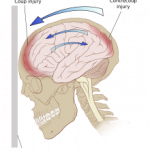Mind Your Stretching!
 A traumatic brain injury can be described as a physical injury to the brain causing an impairment of brain function. When the brain is injured, it can cause conditions such as brain contusions, hematomas and skull fractures. These traumatic brain injuries can range from mild to severe and can cause permanent disability or death.
A traumatic brain injury can be described as a physical injury to the brain causing an impairment of brain function. When the brain is injured, it can cause conditions such as brain contusions, hematomas and skull fractures. These traumatic brain injuries can range from mild to severe and can cause permanent disability or death.
In the United States, an estimated 1.4 million people a year are victims to traumatic brain injuries obtained from motor vehicle accidents, falls, abuse, assault, and sporting accidents. Our brains are organs full of connections and to sever or damage a connection can lead to devastating consequences. Researchers have been trying to uncover why even a small injury has so much of an impact on the brain.
The answer lies in the condition of the brain after an injury. Many traumatic injuries result when the brain undergoes fast acceleration and deceleration. When the head is struck or shaken violently, this rapid acceleration and deceleration occur, causing injuries to the tissues on impact with the cranium.
Scientists at the University of Pennsylvania have been researching the brain and what happens to the brain upon impact. It has been known that blows to the brain can damage the very fragile fibers of our neurons, called axons, referred to as Diffuse Axonal Injury (DAI). DAI is one of the most common and devastating types of traumatic brain injury and is typically the underlying injury in shaken baby syndrome. An infant’s neck muscles aren’t developed enough to support the head and thus with shaking, there is very quick movement of the brain against the sides of the cranium causing damage.
Our neurons are cells made for connections. They consist of a central body (called a soma), dendrites, and an axon. The dendrites receive the message, which then pass down the long axon and over a synapse to the next neuron. Researchers at the University of Pennsylvania have been studying what inside the axon actually breaks. They have found that sudden blows to the brain damages microtubules that bring stability to the axon. These microtubules cannot withstand the quick stretching that results from the injury and then break in response.
In the lab, they are running experiments on these axons to see the effects of stretching and the possible use of medication to minimize axon stretching. The drug Taxol, used for cancer treatment seems to have some promise but it is too early to say if this drug will work on traumatic brain injuries.
For more information, please refer to www.sciencenews.org/view/generic/id/56455/title/Brain_at_the_breaking_point
| Print article | This entry was posted by Jennifer Aiello on March 19, 2010 at 3:55 pm, and is filed under G2C Online. Follow any responses to this post through RSS 2.0. You can skip to the end and leave a response. Pinging is currently not allowed. |
